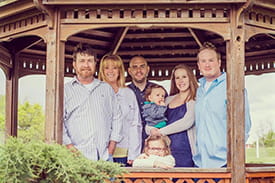The Power of Living Donation
Every day 22 people die while waiting for a life-saving organ transplant.
A sign displaying this fact sits outside of Jill Leeper's office and reminds her of this every morning as she walks by.
“So many people die on the list waiting for a transplant, and it's so sad,” says Jill. “It's important for people to know that there are other options.”
The other option is living donation.
As a living donor for her father, Jill believes that more people need to be aware of living donation and what it really takes to be a donor.
“It's not an easy thing to do. It’s hard and you have to go through a lot of steps, but I would do it again because I gave my dad a second chance at life,” says Jill.
Living-donor liver transplants are possible because of the liver’s unique ability to regenerate, or regrow.
During the operation, a surgeon removes a piece of the living person's healthy liver and transplants it into another person to replace his or her unhealthy liver.
Living donors must:
- Be between the ages of 18 and 65.
- Be in good general health.
- Have an unselfish desire to help someone in need.
Giving Someone a Second Chance at Life
When Jill learned that her father was in liver failure, she rushed to be by his side.
He was already on the transplant waiting list. But, with 15,000 people on the list for a liver transplant, she knew that her father would be waiting for a long time.
Jill knew that living-donor liver transplants were possible, so she volunteered to get tested. Luckily, she was a perfect match.
But, the decision to undergo the transplant was not easy for Jill. With two teenage children, a husband, and a busy career, she knew this was a big step for her to take.
“It was a difficult decision to make, but I could not help it,” says Jill. “He's my father. He gave me life.”
In April of 2007 — with the support of her family — Jill and her father underwent a living-donor liver transplant.
While her recovery was tough at first, Jill gradually started to feel better and went back to work within six weeks.
For Jill, having her family to help and care for her while recovering made all the difference.
“My daughter stayed with me the entire time. She was there for me every step of the way,” says Jill. “Every situation is different but you really do need your support.”
Unfortunately — due to additional health issues — Jill’s father passed away eight years after his transplant. Jill will always remember the gift she gave her father and knows she would do it all over again.
Today, Jill is busy enjoying life with her husband, children, and two beautiful grandchildren.
She believes now — more than ever — people need to know about living donor transplants and the life-saving power that they hold.
How can you help?
If you're thinking about becoming a living donor for someone in need, learn more about living-donor organ transplants.
Jill's results may not be representative of all similar cases.
Learn More about Liver Transplant and Organ Donation
UPMC HealthBeat Blog:
- How You Can Donate Life: Different Types of Organ Donation
- Life After Becoming a Living Liver Donor
- What Is Living-Donor Liver Transplant Surgery?
UPMC Transplant Services:

















